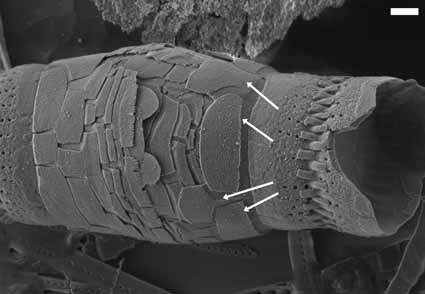Abstract
Nanofrustulum fogedii sp. nov. is described based on a historic sample from Spitsbergen collected by Niels Foged. The new species, originally identified by Foged in 1964 as Nanofrustulum (Melosira) cataractarum, can be separated from the latter by its larger valve diameter, longer striae composed of 1–6 transapically elongated areolae and a higher valve mantle. The species was observed in several samples collected from thermal springs in the Arctic Svalbard Archipelago. Based on its major morphological features, such as the quasifract girdle bands, the small valve dimensions and the serrated linking spines, the transfer of another small-celled araphid species, formerly described as Pseudostaurosira bardii Beauger et al. to the genus Nanofrustulum is justified.
References
- Beauger, A., Wetzel, C.E., Voldoire, O. & Ector, L. (2018) Pseudostaurosira bardii (Fragilariaceae, Bacillariophyta), a new species from a saline hydrothermal spring of the Massif Central (France). Botany Letters 166 (1): 3–13. https://doi.org/10.1080/23818107.2018.1460278
- Foged, N. (1958) The diatoms in the basalt area and adjoining areas of Archean rock in West Greenland. Meddelelser om Grønland 156 (4): 1–146.
- Foged, N. (1964) Freshwater diatoms from Spitsbergen. Tromsö Museums Skrifter 11: 1–204.
- Grana, L., Morales, E.A., Bešta, T., Echazú, D., Wetzel, C.E., Novais, M.H., Rajdlová, H., Ector, L. & Maidana, N.I. (2015) On the Geographical Distribution and Ecology of Pseudostaurosira cataractarum (Bacillariophyceae): New Findings in the Palearctic and Neotropic Ecozones. Brazilian Journal of Botany 38 (4): 809–821. https://doi.org/10.1007/s40415-015-0188-0
- Guiry, M.D. & Guiry, G.M. (2024) AlgaeBase. World-wide electronic publication, University of Galway. Available from: https://www.algaebase.org (accessed 21 August 2024)
- Hustedt, F. (1937) Systematische und ökologische Untersuchungen über die Diatomeen-Flora von Java, Bali und Sumatra nach dem Material der Deutschen Limnologischen Sunda-Expedition. Archiv für Hydrobiologie (Supplement) 15: 131–177.
- Keller, M.D. & Straub, F. (2014) Note on Pseudostaurosira cataractarum (Bacillariophyta, Fragilariaceae) from the thermal Troll springs in Spitzbergen. Publications PhycoEco 2: 1–4.
- Krammer, K. (2000) The genus Pinnularia. Diatoms of Europe 1: 1–703.
- Lee, J.J., Reimer, C.W. & McEnery, M.E. (1980) The identification of diatoms isolated as endosymbionts from larger Foraminifera from the Gulf of Eilat (Red Sea) and the description of 2 new species, Fragilaria shiloi sp. nov. and Navicula reissii sp. nov.. Botanica marina 23: 41–48. https://doi.org/10.1515/botm.1980.23.1.41
- Li, C., Witkowski, A., Ashworth, M.P., Dabek, P., Sato, S., Zglobicka, I., Witak, M., Khim, J.S. & Kwon, Ch.-J. (2018) The morphology and molecular phylogenetics of some marine diatom taxa within the Fragilariaceae, including twenty undescribed species and their relatioship to Nanofrustulum, Opephora and Pseudostaurosira. Phytotaxa 355 (1): 1–104. https://doi.org/10.11646/phytotaxa.355.1.1
- Manguin, E. (1942) Contribution à la connaissance des Diatomées d’eau douce des Açores. Travaux Algologiques, Sér. 1. Muséum National d’Histoire Naturelle, Laboratoire de Criptogamie 2: 115–160.
- Morales, E.A. (2001) Morphological studies in selected fragilarioid diatoms (Bacillariophyceae) from Connecticut waters (U.S.A.). Proceedings of the Academy of Natural Sciences of Philadelphia 151: 105–120.
- Morales, E.A., Wetzel, C.E., Novais, M.H., Buczkó, K., Morais, M.M. & Ector, L. (2019) Morphological reconsideration of the araphid genus Pseudostaurosira (Bacillariophyceae), a revision of Gedaniella, Popovskayella and Serratifera, and a description of a new Nanofrustulum species. Plant Ecology and Evolution 152 (2): 262–284. https://doi.org/10.5091/plecevo.2019.1604
- Morales, E.A., Novais, M.H., García, M.L., Maidana, N.I. & Morais, M.M. (2023) Two new species of Nanofrustulum (Bacillariophyta) from temporary rivers in the Alentejo region, southern Portugal. Nova Hedwigia 117 (1–4): 71–92. https://doi.org/10.1127/nova_hedwigia/2023/0833
- Round, F.E., Hallsteinsen, H. & Paasche, E. (1999) On a previously controversial “fragilarioid” diatom now placed in a new genus Nanofrustrulum. Diatom Research 14 (2): 343–356. https://doi.org/10.1080/0269249X.1999.9705476
- Simonsen, R. (1979) The diatom system: ideas on phylogeny. Bacillaria 2: 9–71.
- Turland, N.J., Wiersema, J.H., Barrie, F.R., Greuter, W., Hawksworth, D.L., Herendeen, P.S., Knapp, S., Kusber, W.-H., Li, D.-Z., Marhold, K., May, T.W., McNeill, J., Monro, A.M., Prado, J., Price, M.J. & Smith, G.F. (Eds.) (2018) International Code of Nomenclature for algae, fungi, and plants (Shenzhen Code) adopted by the Nineteenth International Botanical Congress Shenzhen, China, July 2017. Regnum Vegetabile, Vol. 159. Glashütten: Koeltz Botanical Books, pp. [i]–xxxviii, 1–253.
- Van der Werff, A. (1955) A new method of concentrating and cleaning diatoms and other organisms. Verhandlungen der Internationalen Verein für Theoretische und Angewandte Limnologie 12: 276–277. https://doi.org/10.1080/03680770.1950.11895297
- Wetzel, C.E., Morales, E.A., Blanco, S. & Ector, L. (2013) Pseudostaurosira cataractarum comb. nov. (Bacillariophyta): type analysis, ecology and world distribution of a former “centric” diatom. Acta Nova 6 (1/2): 53–63. https://doi.org/10.6084/m9.figshare.7654673
- Witkowski, A. & Lange-Bertalot, H. (1993) Established and new diatom taxa related to Fragilaria schulzii Brockmann. Limnologica 23: 59–70.


